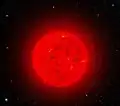Mu Cephei
Mu Cephei, also known as Herschel's Garnet Star due to its red, garnet-like color, is a red hypergiant star in the Cepheus constellation. With a radius between 1,260 and 1,420 solar radii,[1][2] or a diameter between 1.7 and 2 billion kilometers, it is one of the largest stars known. This means Mu Cephei is twice the size of the more famous star Betelgeuse.[3] Mu Cephei is also 269,000 times brighter than the Sun.[4] Mu Cephei is also the "prototype" of the semiregular variable star type.
.jpg.webp)
 Artist's picture
Artist's picture

Mu Cephei compared to the Sun.
Related pages
References
- Kravchenko, K.; Chiavassa, A.; Van Eck, S.; Jorissen, A.; Merle, T.; Freytag, B.; Plez, B. (December 2019). "Tomography of cool giant and supergiant star atmospheres II. Signature of convection in the atmosphere of the red supergiant star $\mu$ Cep". Astronomy & Astrophysics. 632: A28. arXiv:1910.04657. doi:10.1051/0004-6361/201935809. ISSN 0004-6361.
- Emily M. Levesque1 et al 2005. "The effective temperature scale of galactic red supergiants: cool, but not as cool as we thought" Astrophysical Journal 628, 2.
- Mittag, M.; Schröder, K.-P.; Perdelwitz, V.; Jack, D.; Schmitt, J. H. M. M. (2023-01-01). "Chromospheric activity and photospheric variation of α Ori during the great dimming event in 2020". Astronomy & Astrophysics. 669: A9. doi:10.1051/0004-6361/202244924. ISSN 0004-6361.
- Davies, Ben; Beasor, Emma R. (2020-03-21). "The 'Red Supergiant Problem': the upper luminosity boundary of type-II supernova progenitors". Monthly Notices of the Royal Astronomical Society. 493 (1): 468–476. arXiv:2001.06020. doi:10.1093/mnras/staa174. ISSN 0035-8711.
This article is issued from Wikipedia. The text is licensed under Creative Commons - Attribution - Sharealike. Additional terms may apply for the media files.